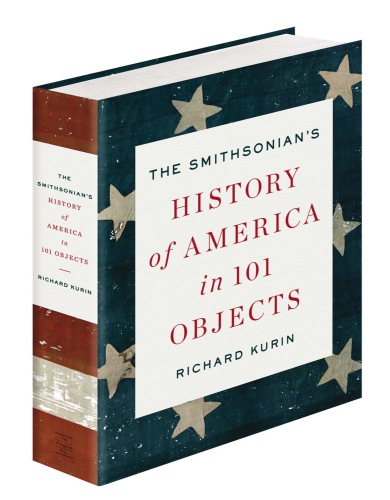
The Smithsonian's History of America in 101 Objects
کتاب های مرتبط
- اطلاعات
- نقد و بررسی
- دیدگاه کاربران
نقد و بررسی

Starred review from July 22, 2013
As Under Secretary for History, Art, and Culture for the Smithsonian Institution, Kurin (Hope Diamond) has intimate knowledge of the organization’s inventory of over 137 million items (that doesn’t include millions and millions of books, photos, documents, recordings, etc.). That blessing had the potential to turn into a curse when he was challenged to select a mere 101 objects that would tell the history of the United States. But he’s done a masterful job. Yes, there are obvious inclusions, like the Declaration of Independence, Neil Armstrong’s space suit, Dorothy’s red ruby slippers from The Wizard of Oz, and the Wright Brothers’ Kitty Hawk Flyer, but even these well-known items have surprising and significant backstories—the Wright Brothers, for example, contacted the Smithsonian for information on research on flying machines prior to their epic flight. (The Smithsonian happily obliged.) Unexpected selections—like vials of Jonas Salk’s polio vaccine, Louis Armstrong’s trumpet, and an Emancipation Proclamation pamphlet that freed slaves carried with them—make the book even more engrossing, and, as in the case of the last item, can make for some emotional reading. Kurin does a terrific job of expanding upon the story of each object, whether it’s a pair of slave shackles or a damaged door from one of the New York City fire trucks that responded to 9/11. This humanistic approach to storytelling (he even includes digressions on things that didn’t make it in, like the ubiquitous stuffed animal named after the first President Roosevelt: the teddy bear) makes for immersive, addictive reading. Photos and illus. throughout.

October 1, 2013
An overstuffed exploration of American history as related through material artifacts, from Meriwether Lewis' compass to relics of the Space Age. The "history of X in Y objects" trope, launched by Neil MacGregor's History of the World in 100 Objects a few years ago, is already in danger of becoming a cliche. Indisputably, though, if you wanted to learn about American history through material holdings, the Smithsonian would be the place to start and end, just as the British Museum served as the trove of first and last resort for MacGregor. Smithsonian Undersecretary Kurin's (Madcap May: Mistress of Myth, Men, and Hope, 2012, etc.) tales are abundant, so much so that it seems almost a shame to stop at a mere 101 items, fat though this book is. For instance, who knew that the original Stars and Stripes, the flag that flew over Fort McHenry during the War of 1812, was packed off to shelter in the Shenandoah Valley of Virginia during World War II because Franklin Roosevelt "feared Germany might bomb the National Mall"? Beginning 500 million years ago, Kurin celebrates the Burgess Shale fossils, which gave Stephen Jay Gould material evidence for his evolutionary theory of punctuated equilibrium; then writes of the bald eagle, "adopted as a national symbol...for its connotations of indomitable force"; and then turns to Clovis points, the tools that early Indian hunters used to bring down mammoths, bison and perhaps even an eagle or two. Rocketing through hundreds of years by way of a Colt revolver, the lyrics to "This Land Is Your Land" and Sitting Bull's sketchbook (again, who knew?), Kurin closes with some of the tools of our time, from Chuck Berry's guitar to the first Apple computer and on to galaxies far beyond our own. A well-conceived and well-illustrated pleasure to read, combining narrative history and keepsake volume.
COPYRIGHT(2013) Kirkus Reviews, ALL RIGHTS RESERVED.

June 1, 2013
Lincoln's hat, Harriet Tubman's hymnal, Sitting Bull's ledger, Cesar Chavez's union jacket, the Enola Gay bomber, even Dorothy's ruby slippers--these are among the objects featured here that tell the story of America. Kurin, the Smithsonian Institution's undersecretary for history, art, and culture, worked with the institution's curators and scholars to make this compendium, which matches photos of each object with a discussion of its creation or discovery and its significance.
Copyright 2013 Library Journal, LLC Used with permission.

October 1, 2013
We all hold on to objects that are laden with our memories. Kurin (under secretary, history, art, & culture, Smithsonian Inst.; Hope Diamond: The Legendary History of a Cursed Gem) presents a chronological selection of Smithsonian holdings that represent the nation's memory, organizing materials according to the themes of U.S. history, from "Before Columbus" to "New Millennium." A guide like this is all the more useful since such a small percentage of the Smithsonian's holdings can ever be on exhibit. The book is much more descriptive than analytical, as Kurin sets each object, beautifully photographed, in its historical and institutional context. The objects cover a wide spectrum: here are all four of Katharine Hepburn's Oscars, Helen Keller's tactile watch, one of only three surviving Mormon moonstones from the Nauvoo Temple, Neil Armstrong's space suit--and the entire Carnegie mansion, now housing the Cooper-Hewitt National Design Museum in New York. VERDICT Written for nonspecialists, albeit insatiably curious ones, this volume will be welcomed by museum visitors, docents, and general history and biography buffs, much like Harold Holzer's The Civil War in 50 Objects and Neil MacGregor's A History of the World in 100 Objects, using collections at the New-York Historical Society and the British Museum, respectively. [See Prepub Alert, 5/13/13.]--Frederick J. Augustyn Jr., Lib. of Congress, Washington, DC
Copyright 2013 Library Journal, LLC Used with permission.

























دیدگاه کاربران